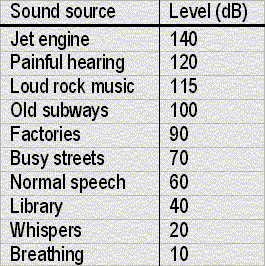
 Location: Ch 2: Sound
Location: Ch 2: Sound

 Location: Ch 2: Sound
Location: Ch 2: Sound
|
 |
SOUND
IN THIS CHAPTER:
|
 ound is produced by
a vibration of some object. When it vibrates back and forth, it moves air
molecules back and forth. As these molecules move back and forth, they
compress and expand, producing compressions and rarefractions. As these
molecules compress and rarefy, they strike our eardrums. The bones in our
eardrums vibrate back and forth, creating pressure changes in the fluids
of our cochlea. As these fluids move back and forth, they stimulate tiny
ear hairs that trigger impulses to be sent to our brain. Thus we perceive
sound. Because sound requires molecules to vibrate, sound cannot travel
through a vacuum. The pitch of a sound depends on the frequency of the
sound. A high-pitched scream has a very high frequency, while a low-pitched
humming has a very low frequency. Sound usually travels at about 340 m/s
in room temperature air. The precise speed of sound can be calculated with
ound is produced by
a vibration of some object. When it vibrates back and forth, it moves air
molecules back and forth. As these molecules move back and forth, they
compress and expand, producing compressions and rarefractions. As these
molecules compress and rarefy, they strike our eardrums. The bones in our
eardrums vibrate back and forth, creating pressure changes in the fluids
of our cochlea. As these fluids move back and forth, they stimulate tiny
ear hairs that trigger impulses to be sent to our brain. Thus we perceive
sound. Because sound requires molecules to vibrate, sound cannot travel
through a vacuum. The pitch of a sound depends on the frequency of the
sound. A high-pitched scream has a very high frequency, while a low-pitched
humming has a very low frequency. Sound usually travels at about 340 m/s
in room temperature air. The precise speed of sound can be calculated with
 the following formula: 331.5 + (0.6)(temperature °C). The speed
of sound in a material, however, depends on the materialís elasticity,
or its ability to resume its original shape. The intensity of a sound is
proportional to the powers of ten. Apparent loudness, on the other hand,
is a psychological sensation that is subjective to the personís brain and
is not related to the speed of sound.
the following formula: 331.5 + (0.6)(temperature °C). The speed
of sound in a material, however, depends on the materialís elasticity,
or its ability to resume its original shape. The intensity of a sound is
proportional to the powers of ten. Apparent loudness, on the other hand,
is a psychological sensation that is subjective to the personís brain and
is not related to the speed of sound.
When any object is struck, it is forced into vibration. This is known as a forced vibration. When any object is disturbed, it vibrates at a special set of frequencies known as its natural frequency. Natural frequency depends on elasticity and shape of the object. Natural frequency is the frequency at which the minimum amount of energy is required to produce and sustain vibrations. Almost all objects have a natural frequency. Interestingly enough, if the natural frequency and the frequency of the forced vibration are equal, the amplitude dramatically increases and resonance occurs. Resonance, while most readily apparent with sound waves, is not restricted to wave motion.
Sound waves can interfere with each other. When sound waves interfere, they affect the loudness of the resulting sound. If two speakers are equally distant from you, the crests of both waves will overlap, producing a louder sound. However, if the speakersí distance are different by a half-wavelength, the crests and troughs will cancel each other out, causing a dramatic reduction in loudness. While the use of interference to cancel out loud noises is great for jackhammer operators, it is not very good for home stereo equipment. An interesting thing happens when two tones of slightly different frequency interfere with each other. The sounds seem to alternate between loud and soft. These periodic variations are known as beats. Beats can be heard when two computers beep at different frequencies. If one beeps at 300hz and the other at 306hz, the crests will be in line three times a second, producing a 3hz beat frequency. Two computers can be made to produce the correct sounds with the two BASIC scripts:
| Computer 1: | Computer 2: |
|
10 cls 15 rem Generates a 300hz tone 20 sound(300, 1) 30 goto 20 |
10 cls 15 rem Generates a 306hz tone 20 sound(306, 1) 30 goto 20 |